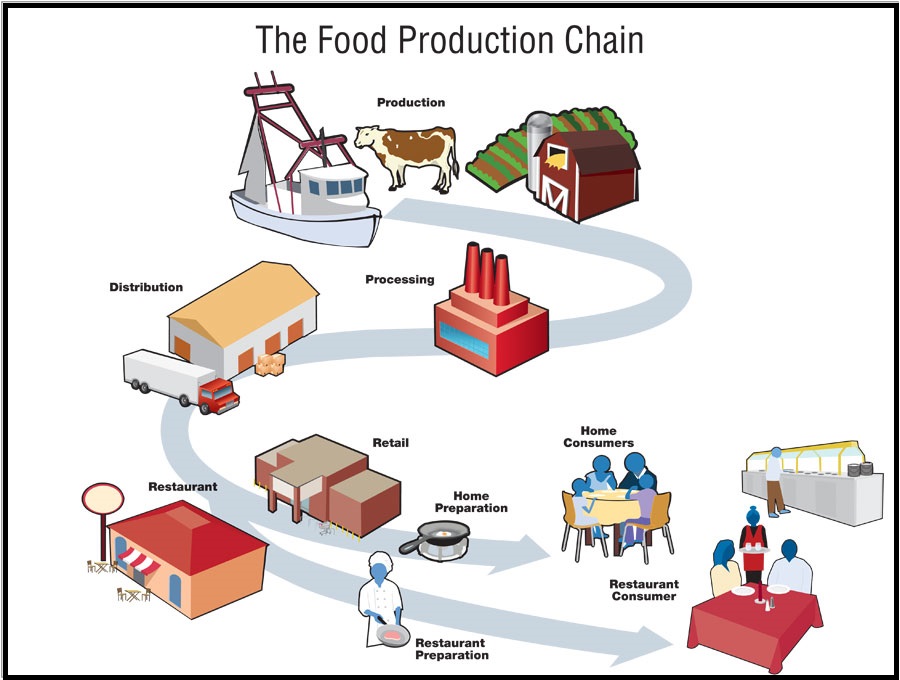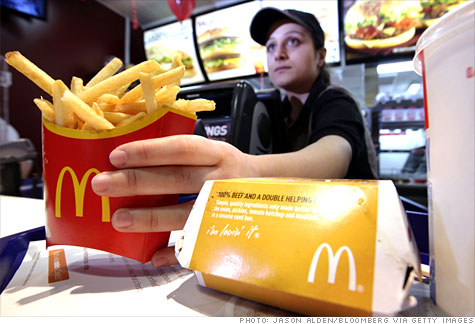Before getting to the headline, I want to remind you what CTH outlined two years ago about these massive food price increases.
 You might remember me saying that processed food prices will increase at a much greater rate than fresh or lesser processed foods. Factually, even organic products (ie. produce) could/would end up less expensive (in relative terms) to the increase in price at your supermarket, as compared to the price increases for the more processed foods.
You might remember me saying that processed food prices will increase at a much greater rate than fresh or lesser processed foods. Factually, even organic products (ie. produce) could/would end up less expensive (in relative terms) to the increase in price at your supermarket, as compared to the price increases for the more processed foods.
The reason is simple, processed food use more energy; energy prices are skyrocketing; the processing costs (packaging, transportation, freezing, sanitizing, storage, warehousing and distribution etc.), at each step of the processing cycle, in addition to higher labor costs, drive up the end result of the price.
In this energy driven inflationary environment, less processing and handling equals lower overall cost increases from field to fork. More processing, handling, distribution equals higher overall costs. This is simply a supply chain, truism.
Into this issue comes McDonald’s Corp. Last I heard, approximately 85% of McDonald’s business was franchise. The franchise has to purchase the product (food) from the main company. Supply side cost increases in the food are transferred from the company to the franchisee via higher product costs. The restaurant is then forced to raise prices to accommodate their increased costs. A portion of the revenue from sales then flows back to the main company.
It is important to note here, there is a natural disconnect in supply side price increases within the franchise model. The parent company must, must, negotiate the best possible contract terms with the suppliers because the increases in costs are passed directly to the franchise. The parent company doesn’t immediately feel any problem until the revenue from the franchise drops due to the forced raising of retail prices and diminished sales. There is a lag.
 McDonald’s is extremely exposed to processed food price increases.
McDonald’s is extremely exposed to processed food price increases.
McDonald’s franchises were forced by supply cost increases to raise retail prices. The retail prices were raised into a primary customer base that is already under extreme inflationary pressure. The average McDonald’s customer is exposed to inflation at almost every level of their life.
A typical family of four will now pay between $30 to $40 dollars for a single meal at a McDonald’s restaurant. That is not practical for the customer base. The result is lowered sales at retail, as eating a meal at home becomes the less costly option. The downstream consequence is lower revenue returned to the parent company.
The only way the parent company can offset the supply side costs to the franchisee is to lower overall operating costs. Expenses have to be cut. Advertising budgets reduced. Administration costs reduced. Administrative staffing levels reduced. Supply contracts renegotiated. Packing, warehousing, distribution and all vendor contracts renegotiated, consistently looking for better terms.
(Wall Street Journal) McDonald’s Corp. is temporarily closing its U.S. offices this week as it prepares to inform corporate employees about layoffs undertaken by the burger giant as part of a broader company restructuring.
The Chicago-based fast-food chain said in an internal email last week to U.S. employees and some international staff that they should work from home from Monday through Wednesday so it can deliver staffing decisions virtually. The company, in the message, asked employees to cancel all in-person meetings with vendors and other outside parties at its headquarters.
“During the week of April 3, we will communicate key decisions related to roles and staffing levels across the organization,” the company said in the message viewed by The Wall Street Journal. McDonald’s declined to comment Sunday on the number of employees being laid off.
McDonald’s in January said that it planned to make “difficult” decisions about changes to its corporate staffing levels by April, as part of a broader strategic plan for the burger chain.
Chief Executive Chris Kempczinski said in an interview at the time that he expected to save money as part of the workforce assessment, but said then he didn’t have a set dollar amount or number of jobs he was looking to cut. “Some jobs that are existing today are either going to get moved or those jobs may go away,” Mr. Kempczinski said.
McDonald’s employs more than 150,000 people globally in corporate roles and its owned restaurants, with 70% of them located outside of the U.S., the chain said in February.
McDonald’s in the message acknowledged that the week of April 3 would be a busy one for personal travel, which it said contributed to the decision to deliver the news remotely. Workers who wouldn’t have access to a computer during the week should provide personal contact information to their manager, the company said. (read more)

…Aaaannnd, everyone’s Apple watch said:
“Your favorite McDonald’s is closing, this means you’ve ALREADY started losing weight, your blood sugar WILL normalize, and you’ll start feeling like a man without all that estrogen laden beef.”
Last time I had a bud was in the late 70’s. Didn’t finish that disgusting brew. If bud and McD’s represent America, well no wonder we’re in trouble.
It is generally not my nature too have a defeatist attitude.
Having said that, I feel as though there are absolutely no
“Republicans” in CONgress, Jim Jordan included, who have the faintest idea of how to proceed in order to rectify this catastrophic injustice perpetrated against President Trump.
I’m fully expecting Jim Jordan and a few others too fire off a series of sternly worded letters which they are famous for. And then, as per usual, nothing….
Maybe Jim Jordan can prove me wrong, but I seriously doubt it, as the “Republicans”abysmal and disgusting track record speaks for itself.
Bottom Line:
The duplicitous, disingenuous, lying sleezebag “Republicans” in CONgress are reprehensible, repulsive and utterly useless.
They just closed down five stores in my area.
Two doughnuts at a Hy-Vee gas station on 10 March? $2.98.
On 24 March? $3.38.
In addition to food issues, would suggest the the economy has caught up with them. The broadest measure of the economy, Gross Output(GO) increased by approximately 1% in the fourth quarter of 2022, while GDP was reported to be up 2.6% . When GO is below GDP it generally says recession ahead. The current weak economy is especially hard on the bottom half of the population, McDonalds major customer base.
I have absolutely no idea why my comment is appearing here as I did not even click on this article.
When I pushed the send button I saw something about McDonald’s flash and I was like Whaaat ?
I attempted to delete this through the editing feature but was ultimately unable to do so.
Have a great day everyone.
I think they will have to go back to marketing children to pressure mom and dad to feed them and entertain them at McDonalds. They have done this in the past with Happy Meals with toys in them, Ronald McDonald appearances, and playgrounds at McDonalds. These tactics were used to overcome price increase hostility from the parents in the past. But parents have long since figured out that the processed food at McDonalds is so crappy, only an ignorant child will eat it.
McDonalds can’t afford the increased costs that would be undertaken to improve the offerings. Fast food stands of every stripe are now in a product cost pinch and some, like McDonalds, have no solutions because they have tried everything already. The only solution other than raising prices will be reducing the volume of food for the customers. Most companies are already headed in this direction(check out your next tube of tooth paste).
The collapse of our economy is on track to enable the political destruction of our Country. And China is helping in every way they can, to facilitate the collapse of what Karl Marx labelled as Capitalism. By now, we are barely hanging on.
I see a lot of “Formerly McDonald’s” signs going up on the franchisees busnesses.
I quit going to McDonalds when they did away with the cash registers.
Fast food chains in the suburbs north of Detroit, have never returned to normal since Covid. Dine in options have just reopened in this area within the past 60 to 120 days and there is no consistent hours of operation do to staffing shortages. I do not dine on any fast food options but you can’t help but notice what is happening to your local businesses in the area and my heart goes out to these business owners who just can not staff their business anymore.
Another factor contributing to McDonald’s woes was the $15+ an hour virtue signaling, wage increases – for entry level jobs.
Dutch : If Minimum Wage kept up with inflation and other wage and benefit increases for oh say Government Employees and WALL STREET BONUS PAYOUTS it would be about $85 bucks per hour .
Cost of burgers goes up raise the price cost of labor goes up OMG WE ARE OUT OF BUSINESS !
If American government and industry had not sold out to cheap labor none of the economic tragedies would be destroying the American people and the nation
well put Robert, but it’s a feature of the monetary system we were given in 1913
Express your satisfaction to any Democrat that supports Biden!
McDonalds is a real estate company in disguise.
Might just be the RE issue many have been waiting for.
Fed not gonna backstop companies.
On the bright side, maybe more Americans will learn to cook their own healthier and cheaper meals.
Easy to make no-knead bread, and crockpots and Instapots also make it very easy to prepare healthy and tasty and inexpensive meals at home.
Min wage increases combined with Biden’s war on oil = fail
Just so long as they don’t cut their ESG programs and diversity officers!!😡
I haven’t been to a McDonalds in about 9 years. Last fast food for me was Chick-Fil-A in 2019. I have no idea what they are charging for food now.
My energy costs have been pretty low. I must be lucky. I had been teleworking 100% for almost 3 months. In Jan I started to go to the office twice a week. I fill up the tank once a month for around $40. I live in a two-bedroom apartment northeast of Balt and my electric bill has only been around $40/month. It hasn’t changed in the past three years. My gas bill went up about 25% but still pretty cheap at around $60/month. I am not feeling the rising energy costs. I feel sorry for those who are.
We don’t eat out unless on vacation or on a business trip. My average grocery bill for two people has dropped from $506/month in 2022 to $445/month this year so far. We are buying the basically the same food. We basically buy whatever is on sale. If meat is on sale we buy extra and freeze it. We currently have about 15 boxes of cereal which were bought on sale months ago.
My GEICO car insurance went up $100/year (from $650 to $750/year) for a 2014 CR-V.
They went woke, so now it is time to go broke. Social Justice meets profit and profit wins. Maybe Joe Biden can bail them out.